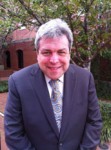A Matzah Memory
 A blog post from Executive Director Marvin Pinkert.
A blog post from Executive Director Marvin Pinkert.
Somewhere along the way in my twenty-five year journey in the museum world, I asked me the question “Can you remember the first exhibit you ever saw?”. I thought for a moment and answered “Sure I can, I was at a long dinner table and someone held up a plate of matzah and asked mah zot?” It had all the elements of an exhibit – an artifact of historic significance, label copy in the Haggadah, it was interactive and at least when we got to the Hillel sandwich – multi-sensory.
I share this by way of confession that while I have a theological appreciation for other holy days, none holds a place in my heart like Passover. I have so many fond memories of seders spent with friends and family that its easy to wax nostalgic about all of them.
There is one seder in my past, however, that truly stands apart. A night unlike all other nights. It was 1978, 35 years ago this season. Passover fell late that year (April 21). I was in Seoul, Korea serving as a “Junior Officer in Training” with USIA. At age 25, I believe I was the youngest American officer serving at the post. So I was somewhat surprised to receive an invitation to the Ambassador’s residence…it was highly unusual for a junior officer to share a social occasion with a senior ambassador. Nonetheless, as there were only five Jewish American officers in Seoul at that time – the Ambassador, the Deputy Chief of Mission, the administrative assistants to both the Ambassador and the DCM and me – I was invited to seder at the residence. I can’t remember all the details but I’m sure my wife gave me some helpful coaching on dinner table manners for such a fine event.
The seder began as expected, but shortly after the first cup of wine, an embassy official entered the room and whispered something into the Ambassador’s ear. Ambassador Sneider rose abruptly and exited the room. I strongly suspected this was more than a second washing of the hands. He returned a few minutes later. After another few prayers and songs, he left the room again, suggesting that we go on with the service. The up and down pattern continued all the way to the cup of Elijah. My recollection is that at about this point the DCM may have revealed what was going on. That afternoon (Korean time) a Korean airliner that had strayed off-course on its way from Paris to Seoul had been fired upon by Soviet aircraft and forced to land on a frozen lake. The 107 surviving passengers had been transported to Murmansk. The Russians were refusing to release the passengers. When the Ambassador left the room he was actually on the phone trying to secure their safe return home. So on that night, “let my people go” had ceased to be an echo of an ancient exodus, but rather a contemporary reality that had made its way to our seder table. It took two days but the passengers did reach their destination (a much happier ending that the second shoot-down incident five years later). I’m sure that any American Ambassador would have made the liberation of the passengers a top priority, but for all these decades I have thought that the fact that a Jewish American Ambassador was a part of this effort on the very night of our own people’s commemoration of freedom was very special – a reminder of the universal resonance of our story.
This year I’ll be headed for Boston, as the torch of making seder passes for the first time to my daughter. Once more I have a feeling it will be a night different from all other nights.
Happy Pesach!
Note: Please respond to this blog to tell us about a seder that you found particularly memorable. It’s one more way to share our history!
